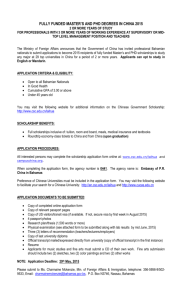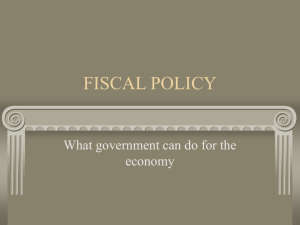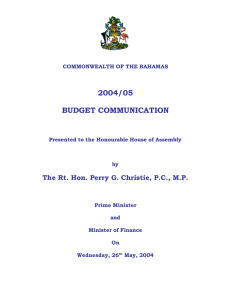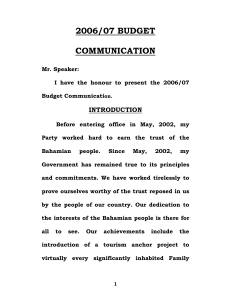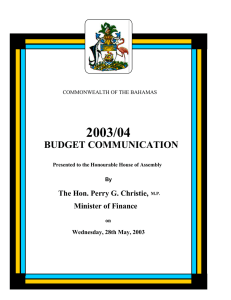2007/2008 BUDGET COMMUNICATION COMMONWEALTH OF THE BAHAMAS
advertisement
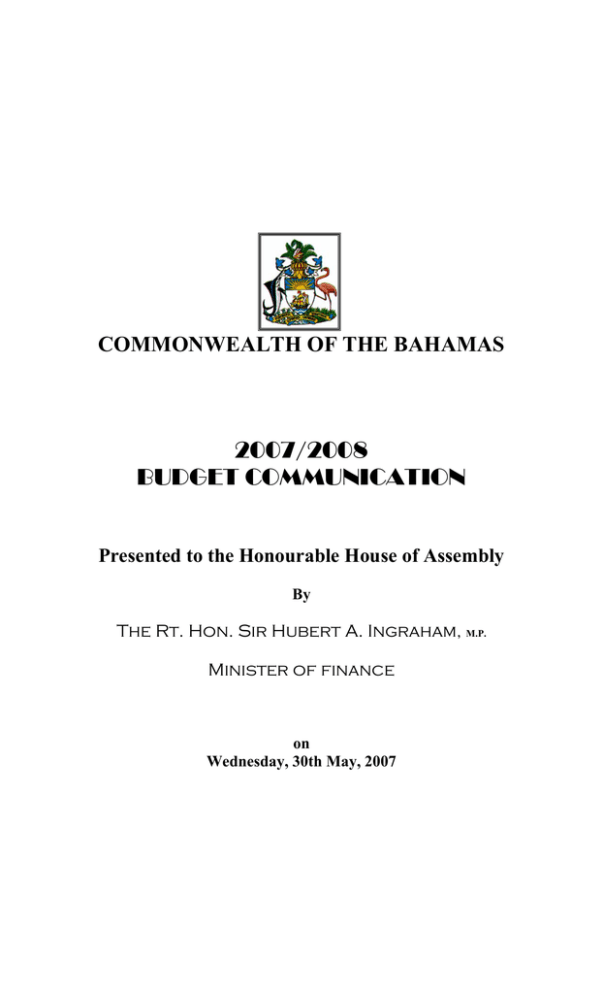
COMMONWEALTH OF THE BAHAMAS 2007/2008 BUDGET COMMUNICATION Presented to the Honourable House of Assembly By The Rt. Hon. Sir Hubert A. Ingraham, M.P. Minister of finance on Wednesday, 30th May, 2007 2007/08 BUDGET COMMUNICATION Mr. Speaker, I have the honour to present the 2007/08 Budget Communication. INTRODUCTION This 2007/2008 Budget is my Government’s first budget in this our third non-consecutive term in office. This budget reflects the aims and objectives of my administration as we begin to implement our Trust Agenda. We, the majority Party in this Honourable House have been entrusted by the people of The Bahamas with the leadership of the Government. We humbly accept that honour and that responsibility. Mr. Speaker, Leadership in public life calls for and indeed, requires integrity, transparency, accountability and compassion so as to engender trust in Government. My government will undergird our administration of the people’s business with these principles beginning with this 2007/2008 Budget. Those entrusted with leadership responsibility ought also to have a clear sense of direction, a demonstrated ability to recognize and assess challenges, and a willingness and ability to make decisions. We in the governing party recognize the challenges facing the Government of The Bahamas at the beginning of this new 2 fiscal period; we have assessed those challenges and we are acting to address them with a focused resolve. Our mission, though challenging is clear. We seek to so govern the affairs of state as to advance the sense of security, wellbeing, pride and prosperity of the people of our nation. As we govern, we want to ensure that we act ethically, fairly and accountably. Most of all, we want to act for all. We want to build trust in government again. International institutions such as the World Bank, the International Monetary Fund and the Inter-American Development Bank, increasingly point to the fundamental importance of establishing and maintaining trust in governmental institutions. They maintain that growth and development increasingly depend on the strength and stability of a society. Hence, where trust in the integrity and quality of governmental institutions exists, that is, where ‘good governance’ exists, economies grow and nations prosper. Consistent with our undertaking to demonstrate transparency, accountability and orderly budgeting, I will submit to this Honourable House in January or February of each fiscal year, a Mid-Year Budget Statement. That Statement will set out the economic background of the fiscal year-to-date, the fiscal performance in the first 6 months of the current fiscal year, and will submit any proposed additions to expenditure for approval. 3 These adjustments, Supplementary Estimates, will be submitted at that time so that this Honourable House and the community at large can see where and why adjustments are necessary. In the course of discussion of these Supplementary Estimates this Honourable House will be able to determine which agencies of Government are implementing orderly budgeting procedures and those which are not. This will ensure that all agencies remain within budget. It will also be possible to determine what are really unforeseen circumstances that give rise to additional expenditures and therefore justify expenditure adjustment, and what do not qualify as “unforeseen”. This procedure will get away from the current situation where Contingencies Warrants are issued and there is an interminable delay in submitting the Supplementary Appropriations validating the Warrants. Indeed, the outcome usually is that the Supplementary Appropropriations are delayed until the end of the fiscal year and buried with the other budgetary documentation. In the interests of transparency, accountability and orderly budgeting this procedure will be eliminated and the procedure outlined put in place. ECONOMIC POLICY Mr. Speaker, our path to a restoration of trust in Government requires a sound and sustained economic policy. 4 Such an economic policy will be supported by a sound fiscal policy. It is for this reason that before setting out my Government’s fiscal policy for 2007/08 I wish to set out my Government’s objective and overall economic policy. We aim, over the next five years, to do the following: ¾ Create good paying jobs for unemployed Bahamians; ¾ Encourage income growth for those who are employed; ¾ Increase Bahamian entrepreneurship and ownership in our economy; ¾ Reduce poverty, particularly in our inner city areas and in our Family Islands; ¾ Create balance in our economic growth by responsibly spreading prosperity to our Family Islands; ¾ Invest our prosperity in the improvement of our society generally: in security, in education, in health, in social welfare and in youth development; and ¾ Safeguard our environment and heritage for present and future generations. ENCOURAGING FOREIGN DIRECT INVESTMENT Mr. Speaker, 5 In pursuit of these objectives we will give priority attention to encouraging and facilitating investment, as was outlined in the Speech from the Throne. There is no doubt, I believe all will agree, that the restoration and expansion of the Bahamian economy over the last fifteen years was substantially achieved by the significant levels of foreign direct investment inflows. Clearly, continued foreign direct investments are necessary to produce the rate of economic growth required to meet our economic and social needs going forward. Our interest in encouraging and facilitating foreign direct investment will be coupled with our determination to encourage and facilitate domestic investment. SUSTAINABILITY Mr. Speaker, while we have the ability, we do not have the right to mismanage our environmental resources thereby compromising our ability to pass on to our children that which has been passed on to us. My Government is firmly of the view that our pursuit of economic growth must be balanced against the environmental needs of future generations of Bahamians. Hence, safeguarding our environment and heritage will be a fundamental tenet of the economic policy of the Government I lead. As a consequence, all investors in our economy, both domestic and international, concerned with financing major 6 capital development projects in The Bahamas will be made aware of our requirement that development meet not only the desired aims of the investor but also the long-term needs of the Bahamian people, most particularly of the people in whose communities projects are being developed. We are confident that enlightened investors share my Government’s ‘environment-friendly’ investment policy. Mr. Speaker, it is my Government’s expressed view that accelerated economic growth, as is necessary for the financial wellbeing of our people, can take place at an environmentally sustainable level and in a way not offensive to our social norms and traditions. It will require, however, that we put equal emphasis on the quality of growth as on the quantity of growth. This will be a decided departure from the way things have been done in more recent times. NATIONAL STATISTICS Mr. Speaker, economic policy cannot be successfully pursued without accurate, timely information. Fortunately, we have virtually at our finger-tips, the required technology to collate and process economic information. What we need is routine, sustained collection of data and its useful application. I cannot overstate the importance of the production of credible national statistics, spanning as full a range as is possible of the nation’s activities, and demographic, social and economic development. 7 including its National statistics must be comprehensive, published in a timely manner and must meet the highest international standard for accuracy and other criteria. To date, we have made a great deal of progress in producing reliable and timely data across a wide spectrum of economic and social activities. Much of the credit for this state of affairs belongs to the Department of Statistics. In recent days it has come to light that data on cruise visitors for 2005 had to be revised. The original data had been prepared by the Ministry of Tourism. The Central Bank of The Bahamas and the Department of Statistics have examined the revised data and have concluded that the impact of the revision on the calculation of Gross Domestic Product and the other economic and monetary aggregates is likely to be minimal. Similar considerations apply to the forecasts by the IMF. The tables and economic commentary annexed to this Communication note this. However, in accordance with our precepts of good governance, my Government believes that the Department of Statistics should in future, sign-off on tourism data and similar economic indicators THE BAHAMIAN ECONOMY The Bahamian economy expanded in 2006 despite moderation in tourism performance during the year. Economic growth was sustained by foreign direct investment inflows and 8 by substantial growth in domestic credit. Foreign Direct Investment amounted to $705.8 million in 2006 of which $233.3 million or 33% represented the sale of land to international persons. Domestic credit in 2006 expanded by 14.3% or $843.4 million. The pace of economic growth was driven by growth in both construction activity and consumer demand. The outlook for construction in 2007 is positive. Data for tourism indicate a moderation in performance for 2006 as total visitors declined by 1.0% to 4.73million and the increase in room revenues slowed. A further moderation in performance is likely to result during 2007 as a consequence of the removal of hotel rooms from service to accommodate refurbishment and replacement. Preliminary data for the 12-month period ending March, 2007, indicated a rate of inflation of 2.3%, and preliminary estimates show a decline in the rate of unemployment from 9.2% to 7.6%. Under pressure of robust credit growth and heavy import demand from investment projects, the Balance of Payments current account deficit grew by $729.5million to $1,582.5million. The result was a tightening in bank liquidity at the end of 2006 and early 2007, and a reduction in foreign reserves of $79million for 2006. 9 Mr. Speaker, the International Monetary Fund’s World Economic Outlook for April 2007, projects the Bahamian economy to grow by 4.5% in real terms in 2007 and by 4.0% in real terms in 2008. These growth rates take into account a slow-down in the growth rate of the US economy from 3.3% in 2006 to 2.2% in 2007 and a slightly increased rate of 2.8% in 2008, there being no major disruption in that economy. In the case of The Bahamas, the projections also take into account the coming on stream of investment projects. Mr. Speaker, I advise that a detailed review of the progress of the Bahamian economy is due to take place in September 2007 when the next IMF Article IV Mission visits The Bahamas. The Mission will provide its usual reasonably objective assessment of the state of our economy and we look forward to that visit. Following the precedent set by my Government in 1999, the Report of the IMF Mission will be published as soon as it is finalized. Later in the year the Rating Agencies will visit us and as their findings are published these too will be available to the Bahamian public and to international investors. FISCAL POLICY Mr. Speaker, sound economic policy must be supported by sound fiscal policy. We realize, and the Bahamian people realize, that confidence in the Bahamian economy, which 10 generates employment and incomes, requires Government to pursue sound fiscal policies. In the Speech from the Throne we specifically commit to a “Balanced Budget” fiscal policy. I make this commitment once again and from 2007/08 we place ourselves on a course that takes us towards meeting this commitment. Thus, the 2007/08 Budget projects a planned Recurrent Budget Surplus, the first such planned Surplus since the 2000/01 Budget. This is the first step in eliminating the overall fiscal deficit – an objective we effectively achieved in 1999/00 and 2000/01. We intend to repeat these achievements in the coming years. Furthermore, Mr. Speaker, we believe that in this Budget we can begin the process of reducing the ratio of Government Debt to GDP. Thereafter, we fully expect to accelerate this progress. Each reduction of 1% in the ratio of Government Debt to GDP is approximately $60million. Thus, a reduction of 3% in the ratio of Government Debt to GDP – bringing the ratio down from 38% to 35% - would represent a reduction in the level of Government Debt of $180million. This reduction in the level of Government Debt would reduce the interest cost of the Debt by about $13million, assuming an overall interest rate of 7%. Moreover, the reduction in the level of Government Debt would release the equivalent amount of resources, $180million, for private sector productive purposes. There would be less 11 interest rate pressures because the Government’s funding requirements would be reduced, and it would open up further prospects for relaxing controls on the outflow of capital. It has to be emphasized that at present the level of Government Debt is manageable but it is crucial to the soundness of the fiscal position of The Bahamas that we move quickly to reduce the ratio of that Debt to GDP and not allow it to drift upwards as it has in recent years. In this context, it will be recalled that in our last term in office we were successful in reducing the ratio of Government Debt to GDP in the years 1999 to 2001 to less than 33%. We know that we can – and will - repeat that achievement. There are a number of policies that will enable us to do so. Firstly, we intend to ensure that the economy expands at the fastest sustainable rate over the coming years. We can point to our successful track record in this regard. A rapid rate of growth can generate the recurrent revenues necessary to reduce the fiscal deficit while also providing scope for expanding expenditure on essential public services and infrastructure. The projections for economic growth in 2007 and 2008 provide confidence that this growth strategy will be successful. Secondly, we intend to be especially prudent in our public expenditure policies. We will carefully heed the demands for 12 priority services and manage expenditure most carefully to ensure that there is full value for money. In this context I wish to place on record my Government’s stance on Public Service pay developments. My Government intends to adhere to the agreement already in existence with the Public Service and Public Sector. When a new agreement or agreements come forward to be negotiated we will deal fairly and equitably with the reasonable pay expectations of all in the Public Service and Public Enterprises. In particular, we will endeavour to eliminate striking anomalies. Finally, we intend to place the highest priority on streamlining our existing revenue structure so as to close loopholes and ensure that revenues are brought to account at an irreducible level. In 2007/08 we are projecting a GFS Deficit of 1.8% largely arising as a result of ‘catch-up’ on essential expenditures. But our projections envisage a planned Recurrent Budget Surplus as a result of which the GFS Deficit will be on a declining trend in 2008/09 and 2009/10. Indeed, by 2012/13 the GFS Deficit should be eliminated and, as I stated, the ratio of Government Debt to GDP down to within the range 30% to 35% of GDP. Clearly our path has to be illuminated by sound and sensible management of both revenue and expenditure. 13 I would now like to turn to our revenue policy. REVENUE POLICY Mr. Speaker, as this Budget and the Speech from the Throne set out my Government’s initial priorities for this term in office, it is important to signal here our stand on fiscal matters, particularly on taxation. My Government intends to simplify the Customs Tariff, and amalgamate Customs Duties and Stamp Tax on imports. We are committed to continually rationalizing and simplifying the Customs Tariff. We commenced this process in 1995 when, it will be recalled, we reduced the number of tariff rates from 129 to 29, concurrently reducing many rates of duty. We reduced the average tariff rate in the country from 45% to about 35%. As regards amalgamating Customs Duties and Stamp Tax on imports, the Ministry of Finance and the Customs Department have been directed to study the administrative and other arrangements which need to be put in place to accomplish this in time for the 2008/09 Budget. The Bahamian people are well aware that my Government completely rules out implementing an income tax system. I believe that in continually stating this position my Government is reflecting a national consensus. Our country has thrived without such a tax to the extent that we are the 14 envy of others. Indeed, the absence of an income tax has contributed to the attractiveness of The Bahamas to foreign investors and to Bahamians alike. The present revenue system continues to serve the needs of our country. It is neither complex nor administratively burdensome and it has contributed to the attractiveness of The Bahamas in securing high levels of foreign direct investment and in attracting high quality providers of international services to our shores. In concluding this part of the Communication, I would like to refer again to the importance of good governance and our commitment to its ideals and practices. I stated in our manifesto “…we fully appreciate that a stable and successful democracy depends on our commitment to the rule of law.” This commitment is of cardinal importance in our revenue policy which is to maintain a low, stable and predictable level of taxation which, in accordance with the rule of law, encourages compliance, reduces the advantages of avoidance, punishes evasion, and enables the tourism, and financial services sectors as well as Bahamian businesses and the Bahamian people, to be clear about their tax obligations. FISCAL PERFORMANCE 2006/07 The Provisional Outturn projected for 2006/07 is for a GFS Deficit of 1.6% of GDP. The GFS Deficit is calculated as Total Expenditure, Recurrent 15 and Capital, less Debt Redemption, minus Recurrent Revenue and Capital Grants. It provides an indicator of the addition to Government Debt arising from the Budget. This is a welcome projected scaling down of the Deficits of the years since 2002/03 and is an improvement of 0.3% on the 2006/07 Budget Estimate. This projection has, of course, to be viewed with some caution because it is not clear if all of the supplementary expenditures authorized by the previous Administration have been brought to account to date. It is widely known that in the closing weeks of that Administration significant expenditures were approved. However, in the course of the Mid-Term Budget Review which will take place in January or February, 2008, we will have more complete data on the 2006/07 Outturn. At that time, full disclosure will be made of the overexpenditures authorized. NATIONAL SECURITY Where appropriate, financial provision is made in the Budget to implement some of the policies set forth in the Speech from the Throne. The highest priority is being given in the 2007/08 Budget to security and law enforcement. This encompasses the judicial system, the Royal Bahamas Defence Force, the Royal Bahamas Police Force, Immigration, Prisons, Customs and the services available to young people. We are also taking steps to deal with 16 the issue of the judicial salary review so as to put that matter to rest. In the case of the Royal Bahamas Defence Force, significant expenditure on additional manpower, new equipment and vessels is provided for in 2007/08. These include 100 additional recruits, 2 aeroplanes, and 4 patrol craft. This will enable the Defence Force to effectively patrol our territorial waters, and deal with poaching, illegal immigration and the movement of contraband. Additionally, my Government is acquiring two 27 foot patrol craft and two 48 foot dauntless patrol craft from the 2006-2007 Budget. The Royal Bahamas Police Force will be expanded by an additional 200 officers. It is envisaged that there will be an obvious and continuous police presence – by way of foot and mobile patrols – throughout The Bahamas. Furthermore, additional technical resources are being provided to augment the capability of the Police to detect serious crime and to bring those responsible to justice speedily. In the case of the Immigration Department, an additional 50 personnel will be recruited and trained, and additional resources are being provided for the repatriation of illegal immigrants. Furthermore, provision has been made in this Budget for 50 additional customs officers. 17 PUBLIC EXPENDITURE 2007/08 Every agency and service is being allocated what are deemed to be its requirements which, with careful and prudent management, should enable them to meet their responsibilities. All Ministers and senior personnel are aware that fiscal resources are limited, and all will be aware that proper management of resources is crucial. If any lapses in management emerge they will be evident in the Mid-Year Budget Statement to which I referred. As I made very clear early in this Communication, my Government is committed to pursuing a strictly disciplined fiscal policy so that only truly unforeseen expenditures will be approved for supplementary funding as the fiscal year progresses. Therefore, the 2007/08 Budget is a firm Budget, and it is intended to enforce strict, fiscal discipline in its implementation. By adhering to a strict disciplined fiscal process the Government will enable The Bahamas to move towards eliminating the deficit within the shortest possible period of years. I have already pointed out the major benefits which the reduction in debt servicing obligations would confer as we move towards reducing the ratio of Government Debt to GDP from its present level of 38% down to about 35%. The 2007/08 Budget sets a limit of 1.8% of GDP on the deficit as compared with 1.6% projected outturn in 2006/07. However, as I mentioned this projected outturn may 18 understate the true deficit because many additional expenditures were authorized in the closing weeks of the previous Administration. The total for Recurrent Expenditure in 2007/08 is $1,465 million. Recurrent Revenue is $1,490 million. This means that there is a planned Recurrent Budget Surplus of $25 million. The major components of Recurrent Expenditure are Debt Interest and Redemption which together amount to $206 million. This is 14% of total Recurrent Expenditure. One can immediately see how a spiraling fiscal deficit could compromise the future. I will not set out the expenditures in detail at this time but intend to highlight a few to demonstrate my Government’s priorities. Each Minister will explain in detail the services which the allocations for his or her portfolio will provide. Therefore, focusing on the major and high priority expenditures, I would like to draw attention to the following services. ¾ The education, youth and culture services receive a total of $265 million, or 18% of total Recurrent Expenditure. Of this, the Department of Education will receive $197million which is an increase of almost $23million or 12% over 2006/07. The College of The Bahamas will receive almost $27million which is an increase of almost $7million or 34% 19 over 2006/07. The Ministry of Education will receive $41million. ¾ Several very important initiatives which my Government is taking are included in these expenditures. Firstly, my Government is restoring the 50% interest rate subsidy under the Education Loan Guarantee Programme. Secondly, my Government is setting aside $3 million for a special quality assurance programme in the education sector whereby participating public schools can draw on funding to hold remedial and special classes to enable pupils to attain basic educational standards. This is a crucial programme to prevent the emergence of social problems and alienation. Thirdly, my Government is implementing a $1 million youth programme whereby young persons will be given financial assistance to purchase tools and/or equipment to start their own small enterprises. ¾ In addition, $2 million is being provided for the National Endowment for Sports; an increase of $1 million. ¾ The Public Hospitals Authority will receive $164million and the Ministry of Health almost $19million. In the case of the PHA, this is an 20 increase of almost $22million, or 15.4% over 2006/07. These allocations will enable the health services to be fully funded and ensure that we fully provide for medicines and other necessities. I have already referred to my Government’s intention to implement a programme whereby persons will receive financial assistance for the purchase of medicines. ¾ The Royal Bahamas Police Force will receive $117million which is an increase of $9million over 2006/07. The Royal Bahamas Defence Force will receive $45million which is an increase of almost $5million over 2006/07. ¾ Local Government in the Family Islands is also receiving a generous increase. ¾ The Ministry of Tourism is being allocated $82million which remains one of the largest allocations in the Budget. ¾ My Government is making a grant of $1million to the Bahamas National Trust to enable them to continue with the excellent work which they do promoting our cultural heritage and protecting our natural environment. My Government has always been supportive of the work of the Trust. 21 We are setting aside $3million to provide relief to those on the lowest income levels as revealed in the Poverty Study conducted by the Department of Statistics and the InterAmerican Development Bank. It is our intention to assist those persons now trapped in the lowest levels of poverty and deprivation escape from their plight, and enable them to lead more comfortable lives. REVENUE MEASURES 2007/08 In the 2007/08 Budget, I am pleased to say, there are no new taxes and no increases in existing taxes. Indeed, I will shortly set out certain reductions in taxation which we are making in 2007/08. Recurrent revenue is projected at $1,490 million, representing an increase of 9.9% over the projected outturn for 2006/2007 and an increase of 10.6% over the original estimate for this year. This projected increase arises from revenue buoyancy and continued focus on revenue collection. The increase in recurrent revenue arises principally from stamp tax which has shown remarkable growth in recent years due to a combination of robust property sales and increased emphasis on revenue administration. Stamp tax as a proportion of total revenues is projected at 27%, just behind customs duties at 41%. Real Property Tax contribution to revenue is projected to increase by 21%. Other contributions to revenue, including customs duties, are projected for only modest increases. 22 The broad aim of the revenue measures in this Budget is to continue harmonizing the rates of duty; to reduce the cost of certain basic food items; and to reduce general costs to the public. Specific revenue measures include: • Customs duties on noodles, infant car seats, and baby walkers; sewing machine needles, sewing thread, bobbins for sewing machines, furniture bases and covers for sewing machines; and fertilizers, insecticides, fungicides, rodenticides are reduced to zero from between 15% and 35%. • Customs duty on juices exceeding 13 ounces is reduced from 50% to 10% to align it with duty on juices under 13 ounces. • Customs duty on doors and windows made of plastic and steel is reduced from 35% to 15% aligning the duty rate to that on imports of windows and doors made of wood. • Customs duty on dishwashers, dishwasher parts, parts for mowers for parks and sports grounds, and for sanitary ware (bathroom fixtures) made of plastics is reduced from as high as 45% to 25%, bringing duty on these items in line with other household finishings and appliances. 23 Customs duty on pleasure vessels of less than 150 gross tons and less than 30 feet in length is now reduced from 20% duty and 7% stamp tax to 5% duty and 1% stamp tax. CAPITAL EXPENDITURE The overall provision for Capital Expenditure is almost $225million. This is an increase of almost 13% over 2006/07 and signals my Government’s commitment to modernizing and expanding the nation’s infrastructure. In this context, my Government attaches the highest priority to developing the Lynden Pindling International Airport and the Marsh Harbour International Airport. These airports will be enabled to borrow the necessary funds on the capital markets and finance the funding by way of user charges. This is an internationally accepted way of proceeding. The Capital Budget makes more than adequate provision for all major heads. In particular I want to emphasise that provision is being made to carry out remedial work on those houses which were built under the previous Administration where the quality of work was poor. As I have said each Minister during the course of the Budget Debate will address the issues which his or her portfolio will deal with, and will explain how the prudent management of resources will be achieved. 24 CONCLUSION Mr. Speaker, our Trust Agenda is initiated. While some engage in the intellectual equivalent of crying over spilt milk, we look toward the future joyfully and we are confidently pursuing new opportunities for our people; for all of our people. My Government is already demonstrating its sense of purpose and industry in addressing the tasks before us. As Manifesto ’07 states:We are bound together by a resolve and a determination to restore trust to government; to make life better for all Bahamians regardless of where they reside in our country, regardless of their station in life, regardless of the level of their formal education and regardless of their skin colour or ethnicity.” We have given our word to the Bahamian people, and this was not lightly given. Indeed, to quote Shakespeare:Mine honour is my life; both grow in one; Take honour from me, and my life is done The 2007/08 Budget is our first financial step along the chosen path of trust, honour, unity of national purpose and decision. We gave our word in the Speech from the Throne and we intend to be true to our word. 30 May, 2007 25 ANNEX A ECONOMIC BACKGROUND 26 ECONOMIC BACKGROUND1 INTRODUCTION In examining economic developments in 2006 and prospects for the Bahamian economy in 2007, this analysis first reviews the international economic environment, which has a direct impact on domestic environment, including policies and trends affecting the financial sector.2 INTERNATIONAL ECONOMIC DEVELOPMENTS According to the IMF3, the global economy expanded by 5.4% (in real terms) in 2006, up from 4.9% (in real terms) in 2005, as a reduction in oil prices, which occurred in the latter half of the year, helped to sustain consumer spending. Nevertheless, strong growth and rising oil prices in the first half of 2006 raised concerns about inflation, resulting in major central banks tightening monetary policy. Further, the majority of the developed countries current account balances deteriorated, reflecting both higher oil prices and increased consumer imports from emerging markets. However, labour market conditions in developed countries improved during 2006, buoyed by heightened economic activity. Preliminary data suggests that economic activity in the United States expanded by 3.3% (in real terms) as compared with 3.2% (in real terms) in 2005, occasioned by an acceleration in exports, non-residential building activity and Government spending, which offset the slowdown in the housing market. With regard to the labour market, gains in professional and business services, retail trade, education and health services and leisure and hospitality services, resulted in a decline in the average unemployment rate to 4.6% at the end 1 The Economic Background is based on material provided by the Central Bank of The Bahamas The Central Bank of The Bahamas and the Department of Statistics advise that the revision to the 2005 cruise visitor numbers will have a minimal impact on the data. Please see note by the Department of Statistics to Table XI. 3 International Monetary Fund World Economic Outlook April, 2007; international data in this Economic Background is from that publication. 2 27 of 2006, compared to a rate of 5.1% at end-2005. Average consumer prices increased by 3.2% as compared with 3.4% in 2005, reflecting moderation in advances to housing, transportation and medical care costs. Moreover, concerns over the country’s deteriorating current account position, combined with the increasing attractiveness of other currencies as interest rate differentials compressed, resulted in a depreciation of the United States dollar against several other major currencies during 2006. In Europe, economic activity in the United Kingdom was 2.7% (in real terms) in 2006, compared with 1.9% (in real terms) in 2005. The Euro area’s output rose to 2.6% (in real terms) as compared with 1.4% (in real terms) in 2005. With respect to the Asian economies, China recorded its fastest pace of growth in more than a decade, as real output advanced by 10.7% (in real terms) as compared with 10.4% (in real terms) in 2005; the exceptionally high level of growth was fuelled by a boom in manufacturing output, a surge in exports and increased domestic investment activity. Japan’s real output expanded by an estimated 2.2% in 2006, occasioned by strong exports and modest expansions in domestic demand, as compared with 1.9% (in real terms) in 2005. In the commodities markets, increased demand for crude oil from countries such as the United States and China, combined with political uncertainty and refining constraints, led to a hike in world prices during the first half of 2006. However, oil prices fell in the latter half of the year due to increased supply and an easing of geopolitical tensions. Nonfuel primary commodities also rose during the review year. Recent reports suggest that global growth is expected to slow in 2007 to 4.9% (in real terms), 2006. which is 0.5% below More specifically, the United States expansion is forecast to moderate from 3.3% (in real terms) in 2006 to 2.2% (in real terms) in the current year, as the sharp downturn in the housing market experienced in 2006, continues to affect the economy. Economic growth is also expected to slow in the Euro zone, due in part to the effect of rising interest rates on 28 economic output. In China, the robust strengthening in real GDP is anticipated to continue unabated during the year, propelled by higher exports and capital investments. In the commodities market, the IMF indicates that oil prices could average $65 a barrel in 2007 and $68 a barrel in 2008, as compared with a high of $76 a barrel in 2006. The IMF notes the volatility of oil prices (arising from geopolitical tension, and the consumption/supply balance). The 2007 forecast assume easing in security tensions in the Middle East, improved supply-demand balance in oil markets and favourable weather conditions which commenced in the second half of 2006, will continue into 2007. Non-fuel primary commodity prices are expected to rise at a slower pace of 4.2%, as compared with the massive growth of 28.4% the previous year, as the firming in food and metal prices tapers. DOMESTIC ECONOMIC DEVELOPMENTS The IMF projects growth of 4% in real terms in 2006, arising from heightened growth in construction activity, consumer demand and foreign direct investment. Indications are that tourism sector output remained subdued, owing to a decline in total visitor arrivals and a reduction in room revenue growth. Despite the surge in crude oil prices, which occurred in the first seven months of the year, inflation remained low. In addition, both liquidity and external reserves contracted, amid the surge in credit as well as increased outflows for oil payments. In fiscal developments, The Bahamas experienced a reduction in the overall fiscal deficit during the first half of the financial year 2006/2007. In the external sector, the current account deficit deteriorated significantly in 2006, due to increased construction-related service outflows associated with the ongoing foreign investment projects. However, the expansion in the deficit was financed largely by foreign investment inflows. The IMF forecasts that the Bahamian economy will grow by 4.5% (in real terms) in 2007, supported by a rise in tourism 29 related foreign investment activities and expansion in the construction sector. Domestic prices are likely to rise moderately, by 1.9%, in 2007 which is close to the projection of 1.7% for the US economy. TOURISM In tourism developments, data for the year indicated a moderation in output, as additions to total room revenues slowed and softening in both sea and air arrivals resulted in reduction in overall arrivals. According to the survey of the largest properties, hotel sector performance indicators for 2006 featured a 4.2% growth in room revenue, which was significantly below the 9.2% advance in 2005. Broad-based growth was recorded across all of the major markets, with New Providence up by 4.1%, Grand Bahama by 5.5% and the Family Islands by 3.2%. During 2006 total visitor arrivals declined by 1% to 4.7 million, owing to a 1.5% contraction in air tourists and 0.8% reduction in sea visitors. By port of entry, total arrivals to New Providence over the January to October period, fell by 8.1% reflecting decreases in sea and air visitors by 11.7% and 2.0% respectively. In the Grand Bahama market, the visitor count was reduced by 0.8%, as the 4.3% fall-off in air passengers eclipsed the 0.9% improvement in sea visitors. In contrast Family Island tourism improved for the year, with robust growth of 20.4% in sea visitors and growth of 3.4% in air visitors resulting in an overall improvement of 17.1% in total visitors. The outlook for the tourism sector is expected to be mixed in 2007. The weakness of the US dollar when compared to other global currencies, should continue to improve the cost competitiveness of the Bahamians tourism product, relative to other European and Asian destinations. However, uncertainty remains over the impact of the Western Hemisphere Travel Initiative (WHTI) on visitors from the United States market; while expectations are that the major cruise operators will 30 continue to shift capacity to more profitable European destinations in 2007. FINANCIAL SECTOR A recent study conducted by the consulting firm Oxford Economics indicates that the financial services industry contributes directly, approximately 15% of the country’s GDP, thus confirming the importance of these activities to the overall growth and development of the Bahamian economy. In the banking sector, merger and reorganization activities of many institutions, to meet the challenges of a more competitive environment, led to a decline in the number of bank and trust company licenses by 2 to 248. The number of public licensees was reduced by 6 to 143, while the number of restricted and non-active operations increased by 4 to105. Since 30 June 2004, except for special managed arrangements approved by the Central Bank, all remaining licensees were required to meet the physical presence requirements, inclusive of a minimum level of dedicated staffing and record keeping within The Bahamas. In adherence to this requirement, the number of licensees operating through physical presence increased by 2 to 215. Another 33 institutions continued under restricted management arrangements approved by the Central Bank. Provisional information from the Central Bank’s Annual Banking Survey showed that overall employment in the sector firmed by approximately 211 persons to 4,662 employees, with Bahamians accounting for 93.7% of the workforce. Moreover, banks’ total expenditures expanded by an estimated 10.5% to $470.5 million, occasioned by increases in operational and capital expenditures of 9.0% and 45.0%, respectively. According to the Office of Registrar of Insurance Companies, during 2005 the number of licensed insurance operations in The Bahamas grew by 15 to 205 at end-2006, while the number of companies operating in the domestic sector rose by 1 to 10. Moreover, domestic brokers and agents and external operators totaled 99 and 10, respectively. 31 The Securities Commission reported increases in the number of active investment (mutual) funds operating from or within The Bahamas, by 3.7% to 725, while the value of funds under management firmed by 17.0% to $205.0 billion. CONSTRUCTION The most recent economic indicators suggest that construction activity firmed during 2006, reinforced by ongoing resort developments, alongside increased residential investments. The outlook for the sector for 2007 remains relatively positive, although the momentum is expected to be somewhat constrained by less buoyant liquidity conditions and will depend on the rate at which foreign investment initiatives progress. During 2006, total mortgage disbursements firmed by 22.5% to $607.9 million, as residential and commercial disbursements increased by 19.4% and 56.1%, respectively. Moreover, outstanding mortgages expanded by 16.0% to $2,503.9 million. The residential component grew at a slightly lower rate of 15.9% from 16.1% and accounted for 91.4% of the total. Moreover, the commercial segment rose by 16.8% from 13.9% in 2005 and accounted for the remaining 8.6% of the aggregate. In contrast, mortgage commitments for new construction and repairs to existing structures―a more forward looking indicator of activity―contracted in both number and value, by 22.9% and 21.3% to 1,451 and $180.3 million, respectively. The residential component, which accounted for the majority (95.4%), weakened by almost 20.0% to $172.0 million. Further, commercial commitments (4.6% share of the total) fell by 42.9% to $8.4 million. Interest rate conditions remained favourable for potential buyers as average commercial and residential loan rates fell by 3 and 1 basis points to 8.9% and 8.3%, respectively. INFLATION Despite the surge in international oil prices to historic highs in the first half of 2006, the economy continued to experience modest inflation, in line with the trends noted in 32 the United States. The domestic inflation rate for 2006, as measured by the change in the Retail Price Index, was 1.83% as compared with 1.95% in 2005. Contributing to this moderation were decelerations in the average costs for transport & communication (1.97%), education (0.44%) and recreation & entertainment services (0.15%). Moreover, average cost increases for housing and medical care & health slowed by 1.10% and 1.67% to 1.66% and 1.75%, respectively. Preliminary data for the twelve-month period ending March 2007, indicated a firming in prices, as the rate of inflation rose to 2.3%, compared to 1.82% in the comparable 2006 period. The strengthening reflected mainly higher costs for other goods & services, food & beverages, and medical care and health. EMPLOYMENT Buoyed conditions, by the general preliminary improvement estimates indicate in economic that the unemployment rate in The Bahamas declined by 2.6% from 10.2% in 2005 to 7.6% in 2006. Among males, the unemployment rate declined to 6.9% in 2006 as compared with 9.2% in 2005, and female unemployment decreased by 11.2% in 2005 to 8.4% in 2006. FOREIGN INVESTMENT AND THE BALANCE OF PAYMENTS Foreign investment reached new levels during the year, largely due to inflows into tourism developments. Capital receipts associated with a number of hotel projects, resulted in the capital account surplus of an estimated $486.3 million to $1,119.4 million. The main drivers of the expansion were direct investments, which increased by 22.7% to $692.1 million, as well as “other investment” inflows which rose almost four-fold to $509.5 million. In contrast, the current account deficit deteriorated substantially, reflecting increased payments for oil imports, weakness in tourist expenditure and heightened consumer demand. The deficit expanded by $729.5 million to $1,582.5 33 million as the merchandise trade deficit firmed by $105.5 million to $1055.7 million. Moreover the services account surplus faced strong headwinds, declining by $576.8 million to $538.3 million. In addition, net current transfer receipts fell to $52.8 million, compared to a value of $85.4 million a year ago, while net income payments rose by $14.6 million to $217.8 million. CAPITAL MARKETS Domestic capital market activity remained upbeat during 2006, as the Bahamas International Securities Exchange (BISX) All Share Price Index rose by 24.1% to 1,676.2 points, vis-à-vis growth of 30.0% a year earlier. As a result, the market capitalization on BISX rose by 20.8% to $3.2 billion. However, both the volume and the value of the shares traded on BISX declined by 21.9% to 5,251,167 shares and $28.7million, respectively. Further, valuation represented by the broader Fidelity Capital Market Limited’s Index (Findex), which captures over-the-counter trading, advanced by 34.5% to 742.2 points following growth of 28.4% to 551.9 in the previous year. The total number of publicly trading companies on the Exchange remained at 19. Inclusive of over-the-counter instruments and mutual funds, the total number of securities trading locally increased by 1 to 28 in 2006, reflecting the addition of the mutual fund, Fidelity Prime Income Fund Limited. Meanwhile, the number of over-the-counter securities remained unchanged at 4. In other equity market developments, Kerzner International’s Bahamian Depository Receipts (BDRS) were repurchased at $8.09 per BDR share, an improvement over the initial list price of $5.14 per share. This transaction formed part of a wider initiative to take the company private, and included the investor group Istithmar PJSC, Whitehall Street Global Real Estate Limited Partnership 2005, Colony Capital LLC, Providence Equity Partners, Inc. and The Related Companies, L.P. 34 Further, discussions between BISX and the Central Bank of The Bahamas regarding the development of a secondary trading market for Government securities were conducted during the year. The meetings focused on a variety of operational and capacity building aspects of this initiative. PAYMENTS SYSTEMS MODERNIZATION The Central Bank and the Clearing Banks’ Association (CBA) modernization of the domestic payments continued in 2006. In this regard, the association forged ahead with plans to implement an Automated Clearing House (ACH) system, which is an electronic funds transfer system that allows interbank clearing of retail payments depository financial institutions. among participating The task force, established by The CBA to oversee the implementation of the ACH system, solicited and reviewed proposals from several vendors for software and hardware solutions and is expected to make a selection during May. For 2006, the total volume of transactions from the clearing banks and the Central Bank through the Real Time Gross Settlement System (RTGS), which was implemented in May 2004, increased by 65.2% to 31,438, while the corresponding value rose by 19.0% to $9.3 billion. Moreover, as part of the sustained movement towards technological advancement, several institutions have implemented per-authorized debits which are primarily used to pay insurance premiums, utility bills and credit cards. Further, indications are that the Customs Department initiated the use of credit cards as a means of payment for Government charges. MONETARY & CREDIT DEVELOPMENTS The 2005 momentum of robust private sector credit growth, which followed the removal of credit restrictions in August 2004, continued during 2006; consequently, both external reserves and liquidity levels contracted significantly. However, banks still continued to adhere to stringent lending standards, as evidenced by the fact that the overall asset 35 quality of the banking system remained at relatively high levels. During the year, the growth in total domestic credit was almost a third higher at $843.4 million (14.3%) compared to $672.3 million (12.9%) in 2005. Developments featured a 13.8% hike in Bahamian dollar credit from 12.7% last year; while foreign currency claims advanced by 17.9%, 3.8 percentage points higher than the previous year’s expansion. Banks maintained their robust lending to the private sector in 2006, as credit firmed by 14.4%, boosting the outstanding level to $5,668.7 million. Specifically, the Bahamian dollar component increased by 15.6% relative to 13.1% in the previous year; while accretions to foreign currency claims, which accelerated by 25.2% in 2005 as a result of funding associated with the Cable Beach re-development project, narrowed to a 3.4% gain in the review period. The main drivers of the growth in private sector credit were residential mortgages, consumer credit and personal overdrafts, which firmed by 16.3%, 14.5% and 44.2%, respectively. Net credit to the public sector rose by 13.6% compared to growth of 6.5% in the previous year. The outcome reflected the floating of a foreign currency bond issue by a public corporation during the latter half of the year, which elevated this sector’s credit growth by 31.0% a reversal from a net repayment of 11.0% in 2005. In contrast, accretions to net claims on Government slowed to 5.4% vis-à-vis 17.4% in 2005. External reserves contracted by $79.1 million or 13.7% to $499.7 million at end-2006, as the country faced strong headwinds from higher international oil prices, heightened import demand and significant outflows related to the purchase of foreign owned assets by local entities. Balances averaged $580.2 million over the year, registering a month-end peak of $665.5 million in May, but then declined markedly in the following months, before posting a modest $49 million recovery in December. At year’s end, reserves were equivalent to an estimated 14.6 weeks of non-oil imports, compared to 18.5 weeks at end-2005. 36 Over the first three months of 2007, buttressed by increased foreign currency receipts, reserves firmed by $123.9 million to $623.6 million; exceeding the $59.1 million build up to $637.9 million in the comparative 2005 period. In 2006, occasioned by increased competition among commercial banks and the tightening in liquidity conditions, the weighted average loan rate fell by 37 basis points to 9.97%; while the counterpart deposit rate firmed by 14 basis points to 3.36%. In terms of the major categories for loans, the average interest rate for consumer loans fell by 26 basis points to 11.96%; overdrafts by 29 basis points to 10.56% and residential mortgages by 23 basis points to 7.84%. Conversely, the average loan rate for commercial mortgages rose by 27 basis points to 8.37%. For deposits, the average savings rate declined by 10 basis points to 2.16%, and the average range for fixed deposit rates widened to 3.17% – 4.17% vis-à-vis 3.13% – 3.62% in 2005. NATIONAL DEBT During 2006, the Direct Charge on Government expanded by 6.6% ($146.5 million) to $2,381.7 million, compared to an increase of 6.5% ($137.3 million) to $2,235.2 million in the previous year. More specifically, Bahamian dollar claims, which comprised the majority (87.9%) of the total, grew by 7.4% ($144.4 million) to $2,093.1 million; while the level of foreign currency debt increased marginally by $2.1million or 0.7% to $288.6 million. Government’s contingent liabilities experienced slight growth of 0.4% ($1.9 million) to $499.1 million in 2006, compared to an increase of 13.0% ($57.3 million) to $497.2 million in the previous period, as net increases in borrowings by The Bahamas Mortgage Corporation and the Education Loan Authority, were negated by reductions in the outstanding obligations of several other public corporations. Public corporations’ outstanding debt advanced by 18.9% ($112.9 million) to $711.6 million compared to a 2.3% ($13.6 million) rise in the previous year. The 37 acceleration was primarily due to the increase in foreign currency debt of 28.4% ($75.1 million), as compared with growth in Bahamian dollar debt of 11.2% ($37.7 million). Given these developments, the National Debt expanded by $148.3 million (5.4%) to $2,880.7 million at end-December 2006, approximately $46.3 million lower than the increase in 2005. Moreover, the total debt service contracted by 16.7% to $84.7 million, as the 30.3% ($21.6 million) decline in amortization payments, surpassed the 16.4% ($5.0 million) hike in interest charges. As a result, the debt service ratio as a percentage of exports of goods and services narrowed to 2.7% in 2006 from 3.3%, while the debt service ratio as a percentage of Government’s revenue remained unchanged at 1.9%. ECONOMIC OUTLOOK FOR 2007 The IMF projects growth of 4.5% in real terms (or about 6.5% in current prices) for the Bahamian economy in 2007. This is based on expectations of further tourism-related investment inflows and the continued expansion in the US economy ― the main market for tourism. As stated, the US economy is projected by the IMF to grow by 2.2 % in real terms in 2007, which with the decline in the exchange rate of US$ could assist the growth of the Bahamian economy. Risks to this outlook may emerge from upward movements in global oil prices, and further softening in the US economic growth, should the downturn in the housing sector spread to other segments of the economy. However, experience in the 1990’s and in recent years indicate that, given a reasonably benign external environment, this rate of growth is achievable and sustainable for some time. 38
